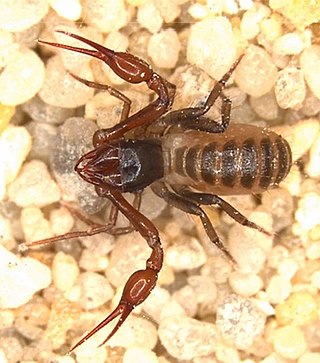
Mole Creek Karst is a national park situated in the North of Tasmania, Australia, 168 km northwest of Hobart. It is located on the slopes of the Great Western Tiers to the east of the town of Mole Creek. It is the only national park in Tasmania created specifically to protect karst landforms. It is part of the Tasmanian Wilderness World Heritage Site.
Tyrannochthonius butleri is a species of pseudoscorpion in the Chthoniidae family. It is endemic to Australia. It was described in 1991 by Australian arachnologist Mark Harvey. The specific epithet butleri honours naturalist Harry Butler (1930–2015), who provided funding for fieldwork in the Cape Range.

Pseudotyrannochthonius is a genus of pseudoscorpions in the family Pseudotyrannochthoniidae. It was described in 1930 by Austrian arachnologist Max Beier.
Pseudotyrannochthonius solitarius is a species of pseudoscorpion in the Pseudotyrannochthoniidae family. It is endemic to Australia. It was described in 1951 by American arachnologist Clarence Clayton Hoff.
Pseudotyrannochthonius jonesi is a species of pseudoscorpion in the Pseudotyrannochthoniidae family. It is endemic to Australia. It was described in 1962 by American arachnologist Joseph Conrad Chamberlin.
Pseudotyrannochthonius typhlus is a species of pseudoscorpion in the Pseudotyrannochthoniidae family. It is endemic to Australia. It was described in 1970 by Australian zoologist Alan Dartnall.
Pseudotyrannochthonius australiensis is a species of pseudoscorpion in the Pseudotyrannochthoniidae family. It is endemic to Australia. It was described in 1966 by Austrian arachnologist Max Beier.
Pseudotyrannochthonius bornemisszai is a species of pseudoscorpion in the Pseudotyrannochthoniidae family. It is endemic to Australia. It was described in 1966 by Austrian arachnologist Max Beier.
Pseudotyrannochthonius hamiltonsmithi is a species of pseudoscorpion in the Pseudotyrannochthoniidae family. It is endemic to Australia. It was described in 1968 by Austrian arachnologist Max Beier.
Pseudotyrannochthonius gigas is a species of pseudoscorpion in the Pseudotyrannochthoniidae family. It is endemic to Australia. It was described in 1969 by Austrian arachnologist Max Beier.

Pseudotyrannochthonius giganteus is a species of pseudoscorpion in the Pseudotyrannochthoniidae family. It is endemic to Australia. It was described in 1971 by Austrian arachnologist Max Beier.
Pseudotyrannochthonius eberhardi is a species of pseudoscorpion in the Pseudotyrannochthoniidae family. It is endemic to Australia. It was described in 1971 by arachnologists Danilo Harms and Mark Harvey. The specific epithet eberhardi honours Stefan Eberhard, who collected the holotype, for contributions to Australian karst research.
Anysrius brochus is a species of pseudoscorpion in the Hyidae family. It is endemic to Australia. It was described in 1998 by Australian arachnologist Mark Harvey. The specific epithet brochus refers to the cheliceral teeth of the male.
Anysrius chamberlini is a species of pseudoscorpion in the Hyidae family. It is endemic to Australia. It was described in 1998 by Australian arachnologist Mark Harvey. The specific epithet chamberlini honours American arachnologist Joseph Conrad Chamberlin.
Ideoblothrus papillon is a species of pseudoscorpion in the Syarinidae family. It is endemic to Australia. It was described in 1991 by Australian arachnologist Mark Harvey. The specific epithet papillon refers to the type locality.
Ideoblothrus woodi is a species of pseudoscorpion in the Syarinidae family. It is endemic to Australia. It was described in 1991 by Australian arachnologist Mark Harvey. The specific epithet woodi honours Ray Wood.
Anatemnus cavernicola is a species of pseudoscorpion in the Atemnidae family. It is endemic to Australia. It was described in 1976 by Austrian arachnologist Max Beier. The specific epithet cavernicola ('cave-dwelling') refers to the species’ habitat.
Austrochernes dewae is a species of pseudoscorpion in the Chernetidae family. It is endemic to Australia. It was described in 1967 by Austrian arachnologist Max Beier.
Austrochernes guanophilus is a species of pseudoscorpion in the Chernetidae family. It is endemic to Australia. It was described in 1967 by Austrian arachnologist Max Beier.
Protochelifer naracoortensis is a species of pseudoscorpion in the Cheliferidae family. It is endemic to Australia. It was described in 1968 by Austrian arachnologist Max Beier. The specific epithet naracoortensis refers to the type locality.

